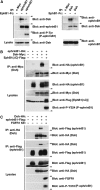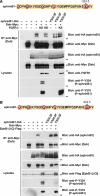Fibroblast growth factor receptor-induced phosphorylation of ephrinB1 modulates its interaction with Dishevelled
- PMID: 19005214
- PMCID: PMC2613129
- DOI: 10.1091/mbc.e08-06-0662
Fibroblast growth factor receptor-induced phosphorylation of ephrinB1 modulates its interaction with Dishevelled
Abstract
The Eph family of receptor tyrosine kinases and their membrane-bound ligands, the ephrins, have been implicated in regulating cell adhesion and migration during development by mediating cell-to-cell signaling events. The transmembrane ephrinB1 protein is a bidirectional signaling molecule that signals through its cytoplasmic domain to promote cellular movements into the eye field, whereas activation of the fibroblast growth factor receptor (FGFR) represses these movements and retinal fate. In Xenopus embryos, ephrinB1 plays a role in retinal progenitor cell movement into the eye field through an interaction with the scaffold protein Dishevelled (Dsh). However, the mechanism by which the FGFR may regulate this cell movement is unknown. Here, we present evidence that FGFR-induced repression of retinal fate is dependent upon phosphorylation within the intracellular domain of ephrinB1. We demonstrate that phosphorylation of tyrosines 324 and 325 disrupts the ephrinB1/Dsh interaction, thus modulating retinal progenitor movement that is dependent on the planar cell polarity pathway. These results provide mechanistic insight into how fibroblast growth factor signaling modulates ephrinB1 control of retinal progenitor movement within the eye field.
Figures







Similar articles
-
Dishevelled mediates ephrinB1 signalling in the eye field through the planar cell polarity pathway.Nat Cell Biol. 2006 Jan;8(1):55-63. doi: 10.1038/ncb1344. Epub 2005 Dec 18. Nat Cell Biol. 2006. PMID: 16362052
-
Tyr-298 in ephrinB1 is critical for an interaction with the Grb4 adaptor protein.Biochem J. 2004 Jan 15;377(Pt 2):499-507. doi: 10.1042/BJ20031449. Biochem J. 2004. PMID: 14535844 Free PMC article.
-
EphrinB1 interacts with the transcriptional co-repressor Groucho/xTLE4.BMB Rep. 2011 Mar;44(3):199-204. doi: 10.5483/BMBRep.2011.44.3.199. BMB Rep. 2011. PMID: 21429299
-
Morphogenetic movements underlying eye field formation require interactions between the FGF and ephrinB1 signaling pathways.Dev Cell. 2004 Jan;6(1):55-67. doi: 10.1016/s1534-5807(03)00395-2. Dev Cell. 2004. PMID: 14723847
-
ephrinB1 signals from the cell surface to the nucleus by recruitment of STAT3.Proc Natl Acad Sci U S A. 2007 Oct 30;104(44):17305-10. doi: 10.1073/pnas.0702337104. Epub 2007 Oct 22. Proc Natl Acad Sci U S A. 2007. PMID: 17954917 Free PMC article.
Cited by
-
Spatial organization of transmembrane receptor signalling.EMBO J. 2010 Aug 18;29(16):2677-88. doi: 10.1038/emboj.2010.175. EMBO J. 2010. PMID: 20717138 Free PMC article. Review.
-
EGFR Phosphorylates and Associates with EFNB1 to Regulate Cell Adhesion to Fibronectin.Mol Cell Proteomics. 2025 Jul 4;24(8):101027. doi: 10.1016/j.mcpro.2025.101027. Online ahead of print. Mol Cell Proteomics. 2025. PMID: 40619000 Free PMC article.
-
TBC1d24-ephrinB2 interaction regulates contact inhibition of locomotion in neural crest cell migration.Nat Commun. 2018 Aug 28;9(1):3491. doi: 10.1038/s41467-018-05924-9. Nat Commun. 2018. PMID: 30154457 Free PMC article.
-
Eph/ephrin signaling in cell-cell and cell-substrate adhesion.Front Biosci (Landmark Ed). 2012 Jan 1;17(2):473-97. doi: 10.2741/3939. Front Biosci (Landmark Ed). 2012. PMID: 22201756 Free PMC article. Review.
-
Roles of ADAM13-regulated Wnt activity in early Xenopus eye development.Dev Biol. 2012 Mar 1;363(1):147-54. doi: 10.1016/j.ydbio.2011.12.031. Epub 2011 Dec 28. Dev Biol. 2012. PMID: 22227340 Free PMC article.
References
-
- Amaya E., Musci T. J., Kirschner M. W. Expression of a dominant negative mutant of the FGF receptor disrupts mesoderm formation in Xenopus embryos. Cell. 1991;66:257–270. - PubMed
-
- Amaya E., Stein P. A., Musci T. J., Kirschner M. W. FGF signalling in the early specification of mesoderm in Xenopus. Development. 1993;118:477–487. - PubMed
-
- Bruckner K., Pasquale E. B., Klein R. Tyrosine phosphorylation of transmembrane ligands for Eph receptors. Science. 1997;275:1640–1643. - PubMed
Publication types
MeSH terms
Substances
Grants and funding
LinkOut - more resources
Full Text Sources
Other Literature Sources
Miscellaneous

